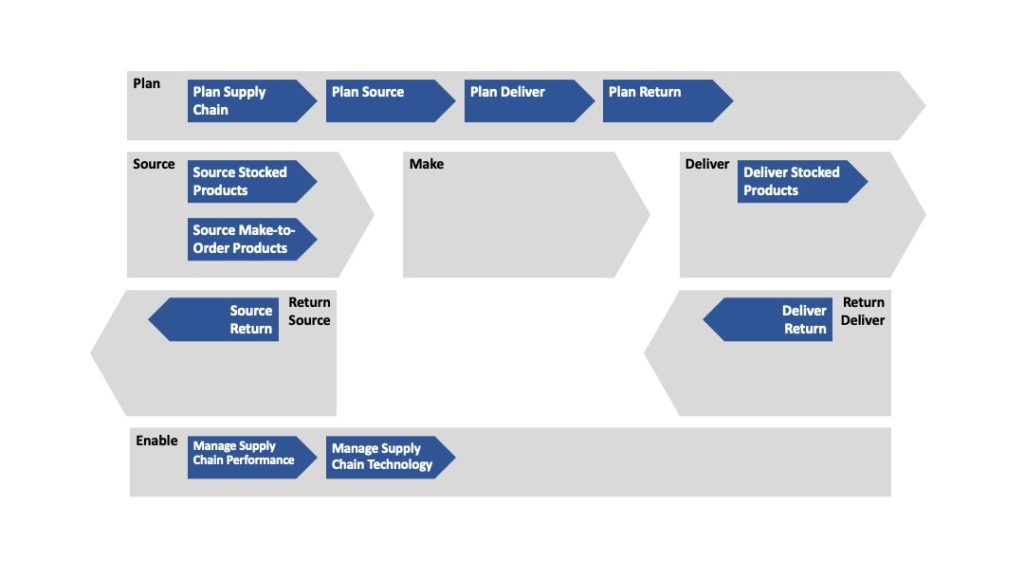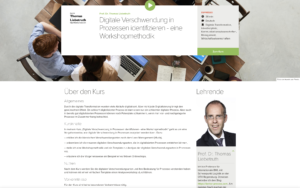Recently the traffic of online-shops rose sharply. And thus the traffic within logistics processes as well as the need to structure and streamline the logistics and supply chain processes. Over the last years I participated in several projects to achieve exactly this. In this post I want to share some of the insights I gained in mapping and developing supply chain processes.
There are several approaches to map processes in general. A widely accepted framework for supply chain processes is the SCOR Model.
The SCOR Model
The SCOR Model (Supply Chain Operations Reference) is a process reference model. It was developed and endorsed by the Supply Chain Council as a cross-industry, standard diagnostic tool for supply chain management. In addition, the model can be used to
- analyze the current state of a company’s processes and goals,
- quantifying operational performance, and
- comparing it to benchmark data.
The SCOR model describes the business activities in supply chains of organizations that serve the purpose of satisfying a customer’s demand. These activities consist on the first process level of the process types plan, source, make, deliver, return and enable. On the second level the process types source, make and deliver are further differentiated in several categories: make-to-stock, make-to-order and engineer-to-order.
Besides processes the model also contains metrics for supply chain performance and practices (emerging, standard, best, declining). Thus the model enables users to address, improve, and communicate supply chain management practices within and between all interested parties across several tiers in a supply chain.
The APICS provides us with a SCOR quick reference guide that contains the basics of the model including the main steps of the process categories and the main KPIs. a more detailed description can be found here (APICS) oder here (CIO).
How to use the SCOR Model to structure and develop supply chain processes (without becoming a member)
To get full access to the model you have to become a paying member (for bigger companies it offers a number of useful services such as benchmarks etc.). But you can use the (free available) resources of the SCOR Model for mapping and developing your supply chain processes without becoming a member. An easy-to-use-approach are the following four steps. I will explain them in the remainder of the contribution after having presented a short case of a fictive online-shop:
- Map the relevant supply chain processes with the SCOR model
- Define success factors depending on your business model
- Derive the most important KPIs to measure the supply chain success
- Establish a technology roadmap
A case of a fictive online-shop

Let’s apply this approach to example-company: A – fictive – small niche-online-shop for local carnival clothes (turnover 2 Mio. EUR, 10 employees). The shop offers some white label products (low margin) and some own-branded products that are custom-made for the online-shop (with relatively high margins). The shop is on the market for a couple of years now and has been growing fastly. It now has reached a point at which it has to structure and develop its operations (supply chain) processes. Suppliers are distributors in Europe (for basic Make-to-stock-products) and Asia (for the custom make-to-order-leather products).
The lead times are for MTS Europe around 5 days and MTO Asia around 100 days. Spontaneous customers are mostly in Germany but the online-shop is available in other languages and deliveries could be made to customers all over the world. The average order size is about 1.5 items per order. Customers can order on the website and on other marketplaces like ebay or Amazon. The fulfillment is done in the local warehouse, for the deliveries KEP-service providers are used (e. g. DHL or UPS). The return rate from customers is in the usual range for online-shops.
The following paragraphs apply the suggested approach for mapping and developing supply chain processes based on the SCOR Model.
1. Mapping relevant supply chain processes
Based on the quick reference guide relevant process categories can be selected. These categories are also shortly described fo the case. The following graph gives an overview of the relevant process categories for our online-shop.

Plan
Even though especially for smaller companies a formal planning process is often lacking, it does make sense to think about some supply chain aspects beforehand:
- Plan Supply Chain: this process is about planning and matching the general requirements of the business model towards the supply chain with the necessary resources. A question for our online shop could be wether the fulfillment is organized in a self-owned warehouse or if this is outsourced to a service provider.
- Plan Source: Here the planning of the offered product range and the necessary suppliers have to be planned. The location of the suppliers has strong influence on lead times and lot sizes and thus stock levels and necessary warehouse capacities.
- Plan Deliver: within this activity sales channels such as the own website, eBay or other marketplaces have to be selected as well as the carriers or packaging materials. Also interesting for the deliver process are public events that influence demand peaks or at least fluctuations.
- Plan Return: A major share of the delivered products are returned by the customers. Therefore the return procedures have to be planned. Such as: when does it make sense to rework and not scrap the returned products and how is this done. Associated with that question are the necessary resources for the return process. The return of defected products to the suppliers is also relevant as it could be a big cost factor.
Source
For the sourcing processes two main categories could be identified:
- Source Stocked Product: basics und accessories are sourced from suppliers or distributors based on catalogues. Usually lead times are shorter and allow flexible sourcing and shorter reaction times.
- Source make-to-order product: One of the main USPs of the shop is that it offers branded local carnival clothes. Those clothes are made to order by suppliers in Asia based on provided designs. Lead times as well as lot sizes are usually larger.
Deliver
In the Deliver category the only process category is the Deliver Stocked Product process. All the products are stocked in a self-owned small warehouse. The orders are verified, the products picked and packed and buffered for the CEP-carriers to be picked up and delivered to the customers.
Return
As usually around 30-40% of the products are returned, effective return processes are important for the success of our online shop. Both return processes – from customers and to suppliers – must be looked at:
- Source Return Defective Product: When defective or simply the wrong products are found in the incoming goods inspection they have to be returned to the suppliers. Also new ones have to be ordered and possibly the payments have to be stopped or reimbursed. It is also possible that suppliers do not accept complaints or returns. In this case the dispute has to be settled.
- Deliver Return Product: Reasons for customers to return ordered products are numerous: wrong product, wrong size, different look and feel as expected, the wish to have a choice or simply also defective products. In the return case the products have to be received and inspected. The next step is to decide if the products are scrapped or reworked and put into the inventory again.
Enable
In the enable category processes could be found that support or provide the infrastructure for the planning and execution processes. For our online shop two enable processes seem to be very relevant:
- Manage Supply Chain Performance: the performance in the supply chain processes is relevant for both the customer and the financial success of the company. Therefore the performance has to be tracked and the right KPIs have to chosen.
- Manage Supply Chain Technology: especially online businesses need a sound technological basis: from a Webshop, APIs to easily integrate processes to other marketplaces or payment service providers, over ERP or WMS to support for picking, packing, labeling and management of the returns.
2. Defining success factors for your business
We can assume that the online shop is on the market for quite some time and has a sound customer basis and a good reputation on the market. Along with this a moderately rising turnover with its branded products guarantees a positive outlook. So, it is not anymore a start-up. We could assume the following success factors:
- Attractive branded products that are complemented with a range of basic accessories: customers order because they know that the shop offers some unique products for local carnivals with a good quality. Competitors offer only cheaper products that are less authentic
- Accurate and fast deliveries along with a customer friendly redemption policy: because of the high quality customers expect a quick treatment of their orders with few errors.
- The good development entails ideas for new product segments and a rising volume. Therefore the complexity of the processes has to be kept on a moderate level and the efficiency must be closely looked at.
3. Deriving the most important KPIs
Based on the success factors the relevant metrics to measure the performance of the supply chain can be derived. Starting with an efficient availability of the products in the sourcing process, the customers must be served swiftly and cheaply in the deliver process and the high return rates must be monitored in order to not undermine the economic success.
Source
The basis to be able to sell products and for a good service level towards the customers is the reliable availability of the products for which the sourcing process is responsible. Therefore the reactivity in the sourcing process must be measured. The most important metric to measure the responsiveness (here in the sourcing process) is the Order Fulfillment Cycle Time. It measures the time from the placement of the order until the good are being received. It can consist of several components such as source cycle time (e. g. the administrative processes to place the order) or if it is a make-to-order product the make cycle time. This must be taken into account when evaluating and comparing the times for different products from different suppliers.
Deliver
For the deliver process both aspects must be tracked: a swift and accurate delivery and an efficient process that consumes as few resources as possible. Therefore the Perfect Order and the cycle times of picking and packing the products should be measured.
The Perfect Order measures if the the orders are delivered on time and in full. A detailed description of theirs important metric that measures the delivery reliability can be found (in German) here. In a nutshell it is calculated by dividing the orders that were delivered on time and in full by the total number of orders. For the delivery of make-to-stock products that just have to be picked from the shelves a value of 95-99% is realistic depending on the products, the order structure and the picking technology.
The metrics Pick Product Cycle Time and Pack Product Cycle Time measure the average time it takes to pick one order line and pack one order. As both processes are often manually, especially for a smaller online-shop, the most costly factor are the people that pick and pack. So the time in this case correlates to a high degree with the cost of picking and packing. And at the same time this metric can be used for the estimation of the staff that is needed to fulfill the incoming orders (on a daily basis but also for peak times such as the carnival season.
Return
In the return process categories both the return deliver and the return source must be covered with metrics. As already mentioned the Return Deliver process accounts for a major share of all activities in the online-shop and must be therefore carefully tracked. An increase of 10% in the returns (which account for around 40% of all deliveries) because of not well explained new products on the website or blurring in the sizes can highly influence the necessary fulfillment capacity needed. Therefore the Return Rate that is calculated by dividing the returned order lines by all order lines is an important metric.
In the Return Source category the Cost to Return is the metric that is used to measure the cost (including personnel and shipping fees as well as fees concerning payment or disputes) is the metric that can measure how much money is lost on poor supplier performance.
Amazon-Affiliate-Link
Are you a student or professional looking for the best tools, resources, and recommendations in your field? Look no further! With this Affiliate-Link you‘ll find products on Amazon that cater specifically to the needs of students and professionals. From innovative gadgets such as micro beamers to essential books on process and supply chain management and office supplies, these products will help you excel in your studies or work. There is no additional cost for you. A purchase via this link is a small token of appreciation for my time in compiling the free information in this post. Make your journey towards success! Happy shopping!
4. Establishing a technology roadmap
Based on the mapped processes, the success factors and the defined metrics, the most important fields of action concerning technological support can be identified. Besides a good IT-System landscape that offers a strongly integrated workflow from the purchase order till the return handling a technology support in the warehouse for the picking and packing seem to be the most important areas of development for our online-shop. Another field of action could be an integrated track-and-trace-system to inform customers as well as the shop itself about the status of the delivery. Here an overview of available technologies for supply chain processes can be found here (in German).
Next steps
When you were successful in mapping and developing supply chain process by using the SCOR model in a first step, the next step can consist in refining and optimizing.
For instance the most critical supply chain processes cans be modeled in detail with simple modeling techniques such as BPMN 2.0 or a logistical value stream analysis.
Online-course on the basics of process management
My online-course is about how you can design processes in such a way that they become even more customer-oriented and efficient. In simple and practical instructions you will learn how to analyze processes comprehensively, identify improvement approaches completely, quantify potentials plausibly and implement measures effectively.



No responses yet